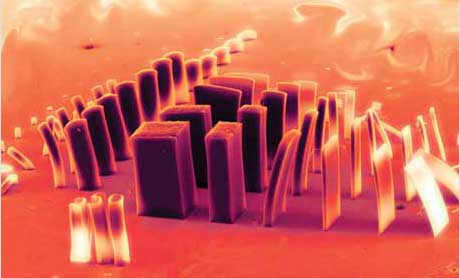We all know that nanotechnology can be applied to medicine in an endless number of ways. These endless ways also include applications in sexual health. University of Washington researchers have developed a way to produce female condoms that incorporate nano-fibers using a method they call “electrospinning”. According to the study, “Electrospinning uses an electric field to catapult a charged fluid jet through air to create very fine, nanometer-scale fibers. The fibers can be manipulated to control the material's solubility, strength and even geometry. Because of this versatility, fibers may be better at delivering medicine than existing technologies such as gels, tablets, or pills.” In other words, they have created thin yet effective condoms that incorporate medicines to prevent STDs as well as prevent pregnancies. This technology is still being researched, but a $1 million grant from the Bill and Melinda Gates Foundation is making that research a little bit easier.
Researchers at the University of Illinois at Urbana-Champaign are using nanotechnology to create conductive ink. This ink is made from silver nanoparticles, which are made even smaller using acid. These very tiny particles are suspended in cellulose solution, which gives them a greater viscosity and allows them to flow from the pen like ink. Circuits can be made as easily as they can be drawn. Circuits can be drawn on uneven surfaces as well, which opens new possibilities for circuit design. Currently, this ink can power something as substantial as a small LED display or an antenna.
Gold nanoparticles are being used by Israeli researchers to detect cancer. These particles are used in sensors, and these “sniffers” can smell the changing proteins and genes of the cancer cells. It can even differentiate between different types of cancer. These sensors are used in a simple test. All the patient has to do is breathe, and these sensors can detect the “smell” of cancer on their breath. The sensors can detect cancer even before tumors show up in x-rays or mammograms.
With so many amazing things possible today, I am excited to see what the future of nanotechnology will look like!
Works Cited
Ball, Cameron, Emily Krogstad, Thanyanan
Chaowanachan, and Kim A. Woodrow. "Drug-Eluting Fibers for HIV-1
Inhibition and Contraception." PLOS ONE:. University of
Washington, 28 Nov. 2012. Web.
<http://journals.plos.org/plosone/article?id=10.1371%2Fjournal.pone.0049792>.
Boyle, Rebecca. "7 Amazing Ways Nanotechnology Is Changing The World." Popular Science.
Popular Science, 14 Nov. 2012. Web.
<http://www.popsci.com/science/article/2012-11/7-amazing-ways-nanotechnology-changing-world>.
Boyle, Rebecca. "Cancer-Sniffing E-Nose Can Differentiate Between Various Forms of the Disease." Popular Science.
Popular Science, 11 Aug. 2010. Web.
<http://www.popsci.com/technology/article/2010-08/cancer-sniffing-e-nose-can-differentiate-between-various-forms-disease>.
Newitz, Annalee. "8 Incredible Nanotechnologies That Actually Exist Today." Io9.
Io9, 10 Dec. 2012. Web.
<http://io9.com/5967198/8-incredible-nanotechnologies-that-actually-exist-in-the-real-world>.
Yirka, Bob. "Researchers Create Rollerball-pen Ink to Draw Circuits." Researchers Create Rollerball-pen Ink to Draw Circuits.
PYHS, 28 June 2011. Web. 30 Nov. 2015.
<http://phys.org/news/2011-06-rollerball-pen-ink-circuits.html>.




